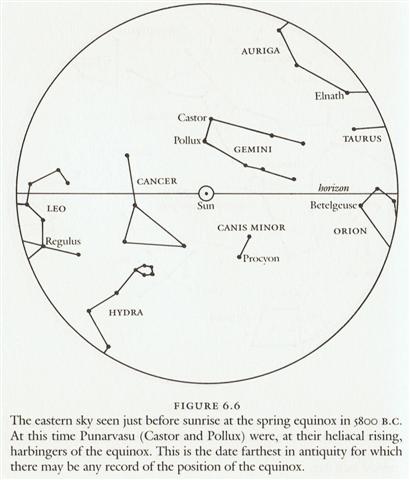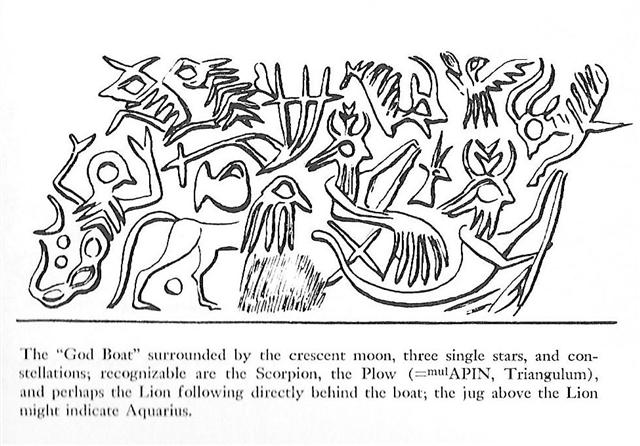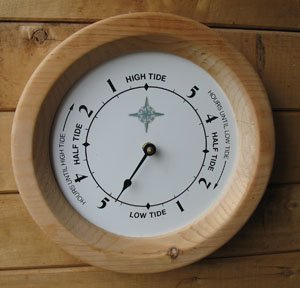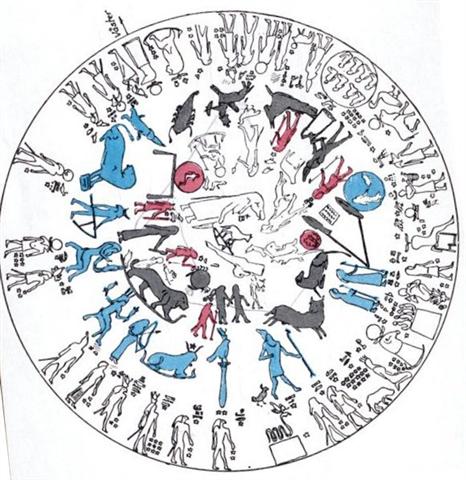The rongorongo texts were probably created in order to be in parallel with the right ascension positions observed in the night sky - together with the corresponding nakshatra positions. Therefore we should keep firm in mind the relevant stars when trying to unlock the secrets of the texts. However, the Chinese, when they were referring to the Star and to the Horse, had pointed away from the expected star positions of Leo at the ecliptic to a place lower down, as if in thought following not the ecliptic but the flow of the Milky Way river:
But a closer look reveals they probably thought about the stars at the celestial equator, i.e. the level defined from Orion and ending between the Head of the Hydra and Alphard. This was similar to how Leo had changed into Water 'midships'.
They did not follow the Raised-up-Sky and they did not follow the Sky-pushed-down. ... The Raised-up-Sky was a region close to Aquila, which seems reasonable because according to the Babylonians the Milky Way was upraised from the place of the Cargo Boat (or the Tea Pot, a part of the South Dipper) beyond which the Eagle & Dead Man were following the Milky Way across the sky ... Instead there seems to have been a need to demonstrate where the old cycle ('old potato') ended (when moving with the seasons), viz. at Orion (and below Gemini). ... needfire ceremonies usually take place near the summer solstice (the Feast of St. John) ... but they occur in several other seasons as well. The summer date of the rite and its accompanying festival have to do, among other things, with fertility, as can can clearly be seen in a variant from the valley of the Moselle preserved for us by Jakob Grimm. Each household in the village was constrained to contribute a shock of straw to the nearby high place, Stromberg, where the males went at evening while the females went to a spring lower down on the slope. A huge wheel was wrapped with this straw. An axle run through the wheel served as the handles for those who were to guide it on its downward plunge. The mayor of a nearby town kindled the straw, for which office he was rewarded with a basketful of cherries. All the men kindled torches and some followed the burning orb as it was released downhill to shouts of joy. The women at the spring echoed these shouts as the wheel rushed by them. Often the fire went out of its own accord before it reached the river, but should the waters of the river extinguish it, an abundant vintage was forecast for that year ...
... In Hindu legend there was a mother goddess called Aditi, who had seven offspring. She is called 'Mother of the Gods'. Aditi, whose name means 'free, unbounded, infinity' was assigned in the ancient lists of constellations as the regent of the asterism Punarvasu. Punarvasu is dual in form and means 'The Doublegood Pair'. The singular form of this noun is used to refer to the star Pollux. It is not difficult to surmise that the other member of the Doublegood Pair was Castor. Then the constellation Punarvasu is quite equivalent to our Gemini, the Twins. In far antiquity (5800 B.C.) the spring equinoctial point was predicted by the heliacal rising of the Twins (see fig. 6.6) ...
The Raven (Corvus) and the Cup (Crater) were below the ecliptic but uplifted above the Milky Way river. And 3 days after Alphard was the Creation of our present world, i.e. 50 right ascension days after Eridu (Canopus). 80 + 15 + 50 = 225 → August 13 (*145):
Presumably the rongorongo creators also allowed themself this kind of liberty (of leaving the ecliptic). For the flow of waters caused by the Moon was at least as important as the path of the ecliptic.
... Moon returns to the same place in the sky after about 24 hours and 50 minutes, which means the tidal period will be half as long (12 hours and 25 minutes) ... 24h 50' corresponds to (24 + 50/60) * 365¼ / 24 = ca 380 right ascension days (= 364 + 16). Presumably the difference between 380 (Moon) and 364 (Sun) - which happened to correspond to the difference between when the star returned to visibility and its true heliacal position - motivated the addition of an extra cycle. Or double-cycle; 2 * 16 = 32 = 760 - 728. Or 1½ * 380 - 1½ * 364 = 570 - 546 = 24.
Therefore we probably should connect the rongorongo glyphs sometimes with the positions at the ecliptic and sometimes with the positions along the flow of waters. South of the equator the brilliant stars Sirius and Canopus surely would have drawn the attention away from the ecliptic path of the planets. Early I assumed Ga2-27 (→ 3.14) implied a point where a new cycle was due to begin, and also counted its length to be 123 right ascension days. We can now count anew: 123 - 16 = 107 (= 471 - 364), and these 123 days could therefore correspond to the length of the watery (Moon) cycle.
... He was moreover confronted with identifications which no European, that is, no average rational European, could admit. He felt himself humiliated, though not disagreeably so, at finding that his informant regarded fire and water as complementary, and not as opposites. The rays of light and heat draw the water up, and also cause it to descend again in the form of rain. That is all to the good. The movement created by this coming and going is a good thing. By means of the rays the Nummo draws out, and gives back the life-force. This movement indeed makes life. The old man realized that he was now at a critical point. If the Nazarene did not understand this business of coming and going, he would not understand anything else. He wanted to say that what made life was not so much force as the movement of forces. He reverted to the idea of a universal shuttle service. 'The rays drink up the little waters of the earth, the shallow pools, making them rise, and then descend again in rain.' Then, leaving aside the question of water, he summed up his argument: 'To draw up and then return what one had drawn - that is the life of the world' ...
But then both manu kake glyphs in the G text should belong in the first part of such a Moon cycle:
If the sunken Argo Navis ship marked a beginning at 8h (30 days after APRIL 17), how far did it stretch? Where did the Ship end?
|
||||||||||||||||||||||||||||||||||||||||||||||||||||||||||||||||||||||||||||||||||||||||||||||||||||||||||||||||||||||||||||||||||||||||||||||||||||||||||||||||||||||||||||||||||||||||||||||||||||||||||||
























.jpg)